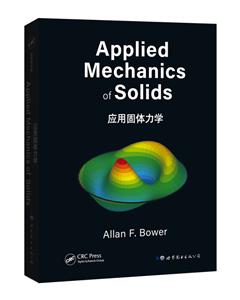-
>
宇宙、量子和人类心灵
-
>
(精)BBC地球故事系列-星际旅行
-
>
从一到无穷大
-
>
图说相对论(32开平装)
-
>
一本有趣又有料的化学书
-
>
刘薰宇的数学三书:原来数学可以这样学全3册
-
>
光学零件制造工艺学
应用固体力学(Applied mechanics of solids) 版权信息
- ISBN:9787519261801
- 条形码:9787519261801 ; 978-7-5192-6180-1
- 装帧:一般胶版纸
- 册数:暂无
- 重量:暂无
- 所属分类:>>
应用固体力学(Applied mechanics of solids) 内容简介
现代计算机仿真模拟使得应力分析变得很容易。随着它们进一步取代分析学中的经典数学方法,这些软件就需要使用者对这些基本原理的基础有一个扎实的理解。 (1) 培养鉴别和避免物理上无意义预测的直观感觉 《应用固体力学》 就是帮助我们理解如何很好地在固体力学领域应用这些革命性的计算机成果。从描述支配着固体变形的数学和物理的定律开始,这本书呈现了现代本构方程、以及应力分析和断裂力学的解析和计算方法。它还讨论了可变形杆、膜、板和壳的非线性理论,以及固体力学中重要的边值和初值问题的解。 (2) 使用自包含的模块和子部分选择和组合主题 借鉴有关线性弹性、塑性和结构力学的经典文献,本书介绍用于分析材料或部件的变形、应力和失效的概念、分析技术和数值方法;探讨有限元软件在应力分析中的应用;评估简单的解析解以解释如何建立适当的边界和初值问题;提供对软件代码中实现的算法的理解;除了作者的网站,这本书的特点是问题集和自学的样本代码,这本书提供了固体力学问题解决的关键概述。它将帮助读者优化使用商业有限元程序,以获得*准确的预测结果。
应用固体力学(Applied mechanics of solids) 目录
Author, xxv
CHAPTER 1 Overview of Solid Mechanics
1.1 DEFINING A PROBLEM IN SOLID MECHANICS
1.1.1 Deciding What to Calculate
1.1.2 Defining the Geometry of the Solid
1.1.3 Defining Loading
1.1.4 Deciding What Physics to Include in the Model
1.1.5 Defining Material Behavior
1.1.6 A Representative Initial Value Problem in Solid Mechanics
1.1.7 Choosing a Method of Analysis
CHAPTER 2 Governin~ Equations
2.1 MATHEMATICAL DESCRIPTION OF SHAPE CHANGES IN SOLIDS
2.1.1 Displacement and Velocity Fields
2.1.2 Displacement Gradient and Deformation Gradient Tensors
2.1.3 Deformation Gradient Resulting from Two Successive Deformations
2.1.4 The Jacobian of the Deformation Gradient
2.1.5 Lagrange Strain Tensor
2.1.6 Eulerian Strain Tensor
2.1.7 Infinitesimal Strain Tensor
2.1.8 Engineering Shear Strains
2.1.9 Decomposition of Infinitesimal Strain into Volumetric and Deviatoric Parts
2.1.10 Infinitesimal Rotation Tensor
2.1.11 Principal Values and Directions of the Infinitesimal Strain Tensor
2.1.12 Cauchy-Green Deformation Tensors
2.1.13 Rotation Tensor and Left and Right Stretch Tensors
2.1.14 Principal Stretches
2.1.15 Generalized Strain Measures
2.1.16 The Velocity Gradient
2.1.17 Stretch Rate and Spin Tensors
2.1.18 Infinitesimal Strain Rate and Rotation Rate
2.1.19 Other Deformation Rate Measures
2.1.20 Strain Equations of Compatibility for Infinitesimal Strains
2.2 MATHEMATICAL DESCRIPTION OF INTERNAL FORCES IN SOLIDS
2.2.1 Surface Traction and Internal Body Force
2.2.2 Traction Acting on Planes within a Solid
2.2.3 Cauchy (True) Stress Tensor
2.2.4 Other Stress Measures: Kirchhoff, Nominal, and Material Stress Tensors
2.2.5 Stress Measures for Infinitesimal Deformations
2.2.6 Principal Stresses and Directions
2.2.7 Hydrostatic, Deviatoric, and yon Mises Effective Stress
2.2.8 Stresses near an External Surface or Edge: Boundary Conditions on Stresses
2.3 EQUATIONS OF MOTION AND EQUILIBRIUM FOR DEFORMABLE SOLIDS
2.3.1 Linear Momentum Balance in Terms of Cauchy Stress
2.3.2 Angular Momentum Balance in Terms of Cauchy Stress
2.3.3 Equations of Motion in Terms of Other Stress Measures
2.4 WORK DONE BY STRESSES: PRINCIPLE OF VIRTUAL WORK
2.4.1 Work Done by Cauchy Stresses
2.4.2 Rate of Mechanical Work in Terms of Other Stress Measures
2.4.3 Rate of Mechanical Work for Infinitesimal Deformations
2.4.4 The Principle of Virtual Work
2.4.5 The Virtual Work Equation in Terms of Other Stress Measures
2.4.6 The Virtual Work Equation for Infinitesimal Deformations
CHAPTER 3 Constitutive Models: Relations between Stress and Strain
3.1 GENERAL REQUIREMENTS FOR CONSTITUTIVE EQUATIONS
3.1.1 Thermodynamic Restrictions
3.1.2 Objectivity
3.1.3 Drucker Stability
3.2 LINEAR ELASTIC MATERIAL BEHAVIOR
3.2.1 Isotropic, Linear Elastic Material Behavior
3.2.2 Stress-Strain Relations for Isotropic, Linear Elastic Materials: Young's Modulus, Poisson's Ratio, and the Thermal Expansion Coefficient
3.2.3 Reduced Stress-Strain Equations for Plane Deformation of Isotropic Solids
3.2.4 Representative Values for Density and Elastic Constants of Isotropic Solids
3.2.5 Other Elastic Constants: Bulk, Shear, and Lame Modulus
3.2.6 Physical Interpretation of Elastic Constants for Isotropic Solids
3.2.7 Strain Energy Density for Isotropic Solids
3.2.8 Stress-Strain Relation for a General Anisotropic Linear Elastic Material: Elastic Stiffness and Compliance Tensors
3.2.9 Physical Interpretation of the Anisotropic Elastic Constants
3.2.10 Strain Energy Density for Anisotropic, Linear Elastic Solids
3.2.11 Basis Change Formulas for Anisotropic Elastic Constants
3.2.12 The Effect of Material Symmetry on Stress-Strain Relations for Anisotropic Materials
3.2.13 Stress-Strain Relations for Linear Elastic Orthotropic Materials
3.2.14 Stress-Strain Relations for Linear Elastic Transversely Isotropic Material
3.2.15 Representative Values for Elastic Constants of Transversely
Isotropic Hexagonal Close-Packed Crystals
3.2.16 Linear Elastic Stress-Strain Relations for Cubic Materials
3.2.17 Representative Values for Elastic Properties of Cubic Crystals and Compounds
3.3 HYPOELASTICITY: ELASTIC MATERIALS WITH A NONLINEAR STRESS-STRAIN RELATION UNDER SMALL DEFORMATION
3.4 GENERALIZED HOOKE'S LAW: ELASTIC MATERIALS SUBJECTED TO SMALL STRETCHES BUT LARGE ROTATIONS
3.5 HYPERELASTICITY: TIME-INDEPENDENT BEHAVIOR OF RUBBERS
AND FOAMS SUBJECTED TO LARGE STRAINS
3.5.1 Deformation Measures Used in Finite Elasticity
3.5.2 Stress Measures Used in Finite Elasticity
3.5.3 Calculating Stress-Strain Relations from the Strain Energy Density
3.5.4 A Note on Perfectly Incompressible Materials
……
CHAPTER 4 Solutions to Simple Boundary and Initial Value Problems
CHAPTER 5 Solutions for Linear Elastic Solids
CHAPTER 6 Solutions for Plastic Solids
CHAPTER 7 Finite Element Analysis: An Introduction
CHAPTER 8 Finite Element Analysis: Theory and Implementation
CHAPTER 9 Modeling Material Failure
CHAPTER 10 Solutions for Rods, Beams, Membranes, Plates, and Shells
应用固体力学(Applied mechanics of solids) 作者简介
Allan F. Bower,毕业于剑桥大学,目前就职于布朗大学。在1991年加入布朗担任助理教授之前,他是剑桥大学工程系的大学讲师。他目前担任布朗/通用汽车公司计算材料研究合作研究实验室的联合主任(与通用汽车公司的马克·韦布鲁奇博士)。
- >
罗曼·罗兰读书随笔-精装
罗曼·罗兰读书随笔-精装
¥40.6¥58.0 - >
月亮与六便士
月亮与六便士
¥13.4¥42.0 - >
新文学天穹两巨星--鲁迅与胡适/红烛学术丛书(红烛学术丛书)
新文学天穹两巨星--鲁迅与胡适/红烛学术丛书(红烛学术丛书)
¥11.0¥23.0 - >
莉莉和章鱼
莉莉和章鱼
¥18.1¥42.0 - >
有舍有得是人生
有舍有得是人生
¥19.4¥45.0 - >
唐代进士录
唐代进士录
¥19.1¥39.8 - >
推拿
推拿
¥12.2¥32.0 - >
经典常谈
经典常谈
¥22.7¥39.8
-
相对论
¥10.2¥32 -
数学物理方法
¥13.2¥27 -
2022图书×抽奖盲袋
¥9.9¥25 -
2023读书月阅读盲盒——天黑,闭眼,刀谁?
¥42.3¥158 -
2022读者节纪念徽章-三星会员专属
¥45¥45.6















